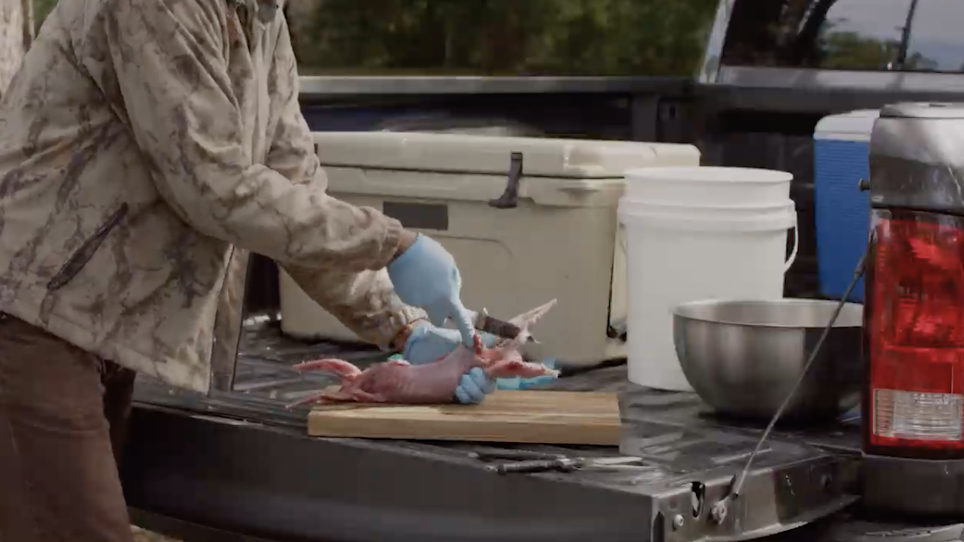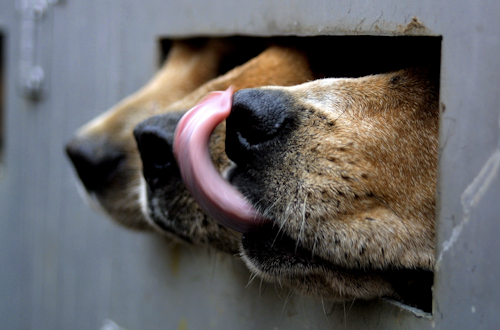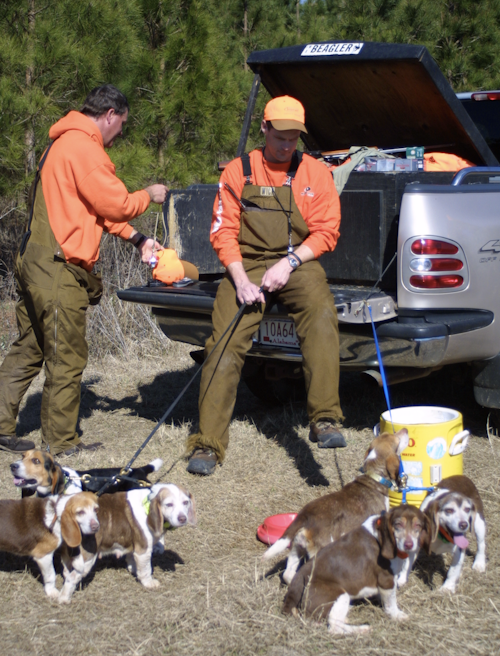
After a successful hunt, it's best to skin and process your rabbits to ensure the best quality for any meals. Having the right tools and a cooler with ice for transport definitely helps. (Photo: Screengrab from AGFC)
Rabbit hunting is one of the most enjoyable ways to spend a day afield, whether you're alone with a handful of shells stomping around brushpiles or with a group of friends and a pack of snuffling beagles.
I've done both, and both are great fun.
When I'm going solo, I'll usually have a handful of Federal shells in my vest pocket and a 12- or 20-gauge, depending on the cover. If it's bushy and thick then I'll take my Mossberg 935, a solid all-around gun for small game, upland birds, waterfowl and turkeys. The 20-gauge likely would poke through the brush, too, but maybe it's just a mental thing when I opt for the 12 and take the 20 for more open terrain.
Taking my time, kicking around brushpiles and briar thickets, watching for a darting bunny and getting a shot here and there is old school hunting at its best. If the thick stuff is mucky I'll have on the boots I wear when I'm raccoon hunting. If it's dry but full of briars and such, my reliable Danner boots and Filson chaps keep me from having shredded legs.
With a group and some hounds, there always seems to be action. Shouts of "Tally ho!" when the beagles strike and then hunters communicating with each other make things more intense. "Through the gap!" and "He's coming toward you!" and "Watch the dogs! There's the rabbit! Tally ho! Tally ho! Get 'em boys!" keeps everyone on their toes.
Smart hunter tip: stick around where the rabbit was jumped and, most of the time, it'll circle back. If you keep a sharp watch you can spy the brown blur heading back to its original spot.

History of Rabbit Hunting
Rabbit hunting has a long, storied history in the United States and Europe, the latter of which dates centuries and involves a variety of methods.
Falconry was the sport of kings, with trained harriers set forth to seek and kill rabbits or other game. Nobles considered this sporting and enjoyed the camaraderie along with, no doubt, the bragging rights of owning such well-trained birds of prey. It still is in practice today, commanding the same dedication to training and enjoyment by those practicing it. It still is popular in the Middle East, too, sometimes causing international situations and with the egos involved with money and changing ideas.
In Europe, rabbits were hunted — along with foxes — by hounds pursued by hunters on horseback. "Riding to the hounds" wasn't just a catchphrase; it was how things were done, with the pack of hounds loosed to find its quarry. Upon striking the trail, the horn sounded along with shouts of "Tally ho!" and off went everyone, galloping to the pack in pursuit. While the beagle is entrenched in modern hunters' minds as the ultimate rabbit dog, greyhounds, daschunds and other hounds were used in Europe.

Today, beagles primarily are the top dog in the rabbit hunting world. You'll find some hunters with other breeds, of course — maybe a redbone or bluetick, perhaps even a greyhound or feist. Nothing wrong with any of them if they can put a nose on a track and get after it. But mention rabbit hunting to anyone and chances are good that a beagle will come to mind.
In the 1800s rabbit hunting probably wasn't called rabbit hunting. It was just part of survival mode, the "Gon' hunting" part when a man or boy might slip off for a walkabout. We revel in the Daniel Boone image of a buckskin clad hunter coming back with a mix of squirrel and rabbit for the pot, or a deer. Flintlock rifles with patched ball over powder gave way to shotguns and rifles. Ammunition eventually became more readily available than ball-and-powder, but no one wanted to miss. If you missed, you perhaps didn't have meat to go with the broth and bread.
By the 1940s small game hunting reached its peak in the United States, depending on which statistical model or economic data you read. A tumbling progression of events changed things: the exit from the Depression and Dust Bowl era, World War II, monumental growth of cities with homes and businesses expanding into "suburbs," other commercial development, declines in small farming and growth of commercial farming, and myriad other factors. Big game hunting began to take a foothold as state conservation departments stocked deer and populations grew. Outdoors media magazines glorified the big game hunts, with occasional stories on small game mixed in, as they realized interest in and advertising for deer, elk, moose and waterfowl was better than for squirrels and rabbits.
Just as we looked at Boone in his buckskins as a bygone era, the days seemed to slip away of a hunter with his hound roaming the patchwork farm for quail, grouse, squirrels or rabbits. It didn't die completely. Things just changed.

Rabbit in the Pot
Today's rabbit hunter typically is one of two things: a diehard who trains dogs and usually doesn't hunt anything else, or a casual hunter who enjoys it but goes with friends when he gets the chance. The former may live where he can raise and train his dogs. The latter, often, in a city or suburb where he cannot.
The good thing about living in the city, though, is if you're a hunter you still can create some dynamite meals with your wild game. It just takes time to skin and process a rabbit properly, or whatever game animal protein you have, to get the best meals possible. If Andrew Zimmern can find a coyote in New York and cook it, you can make a fine rabbit stew at your home in Suburbiville.
A couple of tips I've learned over the years:
— When you kill a rabbit and it's still warm, you can sling the guts out of its anus and eliminate one aspect of the cleaning process. Not kidding. With its belly turned up toward you, with one hand squeeze the ribs to push the guts toward its hind legs. Then do that with the other hand, until you get everything pushed down. Keeping your hand (or hands) tight, raise the rabbit overhead and quickly sling it between your legs while pushing the guts out. They should — again, with a just-killed or warm rabbit — sling out of its body.
— If you don't want to try that or have cold rabbits in a vest, the guts will stink. Rabbits eat and digest grass, seeds and bark in winter. They metabolize a lot. Their guts stink, even if you don't nick the stomach or intestines. They just do. Once you skin the rabbit, get the guts out quickly and get the meat into salty water.
— If you have a cutting board and knife, that's cool. Make sure the knife is sharp. I like to also have a good set of scissors designed to cut meat. They snip through joints, bones and cartilage, and to me are invaluable. We have a couple in our kitchen at home, and when I go on the road I usually have at least some cheapo scissors with me.
— Don't forget the resealable storage bags — I like the gallon size — and ice for the cooler. Get good bags, too, and not the thin cheap ones just to save a dollar. The sturdier freezer bags will hold up better. Take a Sharpie to write on the bags, too, so you won't forget what's in them — hind legs, saddles, shoulders.
The video from the Arkansas Game & Fish Commission shows some great tips to skin and process a rabbit.





